Serotine
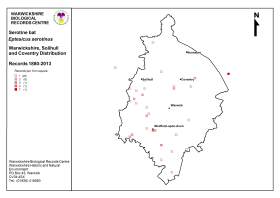
Distribution map for Serotine bats in Warwickshire. (Click for a full sized image)
The
Serotine (Eptesicus serotinus) is one of our less common species
and is found mainly south of a line from The Wash to parts of South Wales.
It is found over most of Europe where it is declining in abundance in some
areas but may be increasing its range northwards. Serotines are not believed
to be particularly migratory although movements of up to 330 km (200
miles) are recorded in eastern Europe.
The Serotine has probably declined due to loss of feeding habitat where
large insects such as chafers can be found. As it roosts almost entirely
in buildings it is subject to the effects of building work and the use
of toxic chemicals in remedial timber treatment.
flight & ultrasound
The Serotine bat is one of Britain's largest bat species and usually
one of the first to appear in the evening, often emerging in good light.
The broad wings and a leisurely, highly manoeuvrable flapping flight with
occasional short glides or steep descents is distinctive. It flies at
about tree-top height (to about 10 m) often close to vegetation, and will
sometimes flop, wings outstretched, onto the foliage to catch large insects.
The Serotine will feed around street lamps and even catch prey from the
ground.

Most of the food is caught within 2 km of the roost although they may
forage up to 6 km. Having caught their favourite prey (a large beetle),
a Serotine will cruise around slowly, chewing and dropping the wing cases
and legs. Sometimes they will take the prey to a feeding perch.
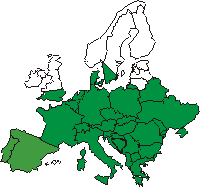 The echolocation calls of Serotine bats range from 15 - 65 kHz and peak
around 27 kHz. On a heterodyne bat detector
an irregular hand-clapping sound is heard which has been described as
"having the rhythm of a very poor jazz drummer".
The echolocation calls of Serotine bats range from 15 - 65 kHz and peak
around 27 kHz. On a heterodyne bat detector
an irregular hand-clapping sound is heard which has been described as
"having the rhythm of a very poor jazz drummer".
Serotine calls can be confused with those of the Noctule
or Leisler's:
Serotine's do not make the chip-chop 2-part call of the Noctule but just
a "chop" that is loudest at about 27 kHz. If a "chip-chop"
sound is heard with a heterodyne detector set to 25 kHz Serotines can
be discounted. However, Noctules can drop the first part of their call
when flying in a more cluttered environment. Serotines are found more
frequently at the edges of landscape features such as tree lines or hedgerows
whereas Noctules prefer a very open environment.
Leisler's has a loud call that is similar to the Noctule ("chip-chop")
but with many more "chips" than "chops". The Leisler's
"chop" is normally heard best above 20 kHz (at around 25 kHz)
as opposed to the Noctule's "chop" which is generally heard
best below 20 kHz.
 Serotine bat call recorded on a Time Expansion bat detector.
Serotine bat call recorded on a Time Expansion bat detector.
Breeding
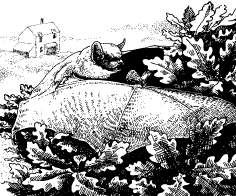 Maternity
colonies consist almost exclusively of female bats and start to build
up in May. Numbers in smaller maternity colonies are often stable from
the end of May.
Maternity
colonies consist almost exclusively of female bats and start to build
up in May. Numbers in smaller maternity colonies are often stable from
the end of May.
A colony usually remains at a single roost site during the breeding season
but some, particularly larger colonies, change roosts. Females normally
give birth to a single young in early July, though births as late as mid-August
have been recorded. The baby is occasionally carried by its mother for
the first few days. At 3 weeks the young are able to make their first
flight and at 6 weeks can forage for themselves. The colony usually disperses
by early September but a few bats may remain until early October.
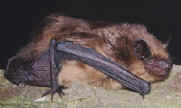 The
males probably remain solitary or in small groups but are occasionally
found with females in spring or autumn. Mating normally takes place in
the autumn but almost nothing is known of the mating behaviour. Males
and females reach sexual maturity a year after their birth.
The
males probably remain solitary or in small groups but are occasionally
found with females in spring or autumn. Mating normally takes place in
the autumn but almost nothing is known of the mating behaviour. Males
and females reach sexual maturity a year after their birth.
summer roosts
Serotines roost mainly in buildings with high gables and cavity walls
such as many built around 1900. They can be found in much older buildings,
and often occur in churches, but are less frequently found in modern buildings.
The access to the the roost is usually at or near the gable apex or the
lower eaves. The Serotine is one of the most building-orientated species
and is hardly ever found in trees, which presumably provided the original
natural roost sites.
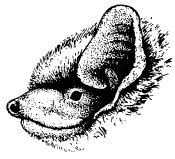 They
roost hidden in crevices around chimneys, in cavity walls, between felt
or boarding and tiles or slates, beneath floorboards and sometimes in
the open roof space at the ridge ends or occasionally elsewhere along
the ridge. Droppings are often present in large amounts at the gable ends
or around a chimney base, although some long established colonies show
no obvious signs of occupation where the roost is in a cavity wall. The
point of access is not well marked, though sometimes it is slightly discoloured
and there are likely to be a few droppings underneath.
They
roost hidden in crevices around chimneys, in cavity walls, between felt
or boarding and tiles or slates, beneath floorboards and sometimes in
the open roof space at the ridge ends or occasionally elsewhere along
the ridge. Droppings are often present in large amounts at the gable ends
or around a chimney base, although some long established colonies show
no obvious signs of occupation where the roost is in a cavity wall. The
point of access is not well marked, though sometimes it is slightly discoloured
and there are likely to be a few droppings underneath.
Once the colony has built up in late spring there may be much squeaking
before the bats emerge at night. Most of the colony emerges in the first
10 minutes and all will have left within about 40 minutes. In spring the
bats return after about 30 minutes and groups of bats will circle around
the roost before entering. As the season progresses, some may return to
the roost in the middle of the night while others spend more time away
from the roost. There may be a secondary peak of activity around dawn.
The roost building is sometimes shared with Pipistrelles
or Long-eared bats, and Serotines have
also been known to associate with Natterer's,
Whiskered and Noctule
bats.
winter roosts
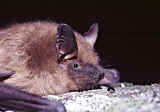 Very
few Serotines are found in winter but it is likely that most hibernate
in buildings. It is possible that at least par of the summer colony may
remain in the same building for some, if not all, of the winter period.
Very
few Serotines are found in winter but it is likely that most hibernate
in buildings. It is possible that at least par of the summer colony may
remain in the same building for some, if not all, of the winter period.
Hibernating Serotines have been found inside cavity walls and disused
chimneys. Very rarely they have been found in the coldest parts of caves,
either in roof crevices or in accumulations of boulders.
| Description |
|
| Head and Body Length |
58 - 80 mm |
| Forearm Length |
48 - 55 mm |
| Wingspan |
320 - 380 mm |
| Weight |
15 - 35 g |
| Colour |
Fur dark brown above, pale underneath; face and ears
black. |
|
|
| |
|
| Life Cycle |
|
| Mating Period |
September - October |
| Maternity Colonies |
Established late spring.
Young: 1 born end of June to early July, weaned at 6 weeks. |
| Colony Size |
15 to 30 bats (up to 60 or more) |
| Longevity |
Up to 19 years. |
| UK Status |
Vulnerable. |
|
|
| |
|
| Habitat and Food |
|
| Summer Roosts |
Buildings. |
| Winter Roosts |
Probably buildings. |
| Feeding Habitat |
Pasture, parkland, open woodland edge, tall hedgerows,
gardens, suburban areas. |
| Food |
Spring: mainly flies and moths.
Summer: particularly chafers and dung beetles.

|